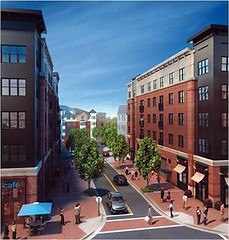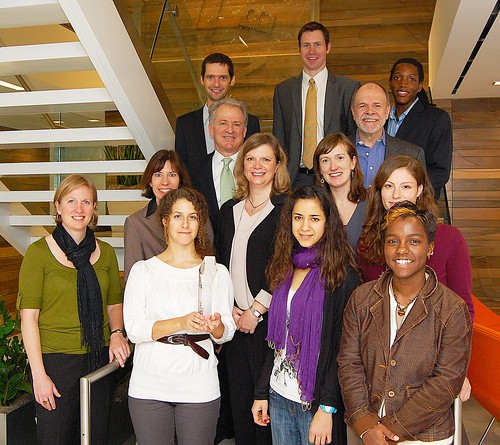Green development award program honored for outstanding achievement

Posted November 15, 2011 at 1:28PM
Last week, NRDC was honored to join the US Green Building Council and the Congress for the New Urbanism, our co-founders of LEED for Neighborhood Development, in accepting the 2011 Outstanding Achievement Award from the Renewable Natural Resources Foundation. Each year, the Foundation recognizes a project, publication, piece of legislation or similar concrete accomplishment for the environment and natural resources.
As many readers may know, LEED-ND establishes objective, measurable performance standards for smart, green land development, and provides green certification at various levels of achievement to projects that qualify. NRDC worked with USGBC and CNU to develop LEED-ND in order to reward planners and developers who pursue smart growth, to provide governments with a template for promoting sustainable practices, and to help citizens tell good development from the not-so-good. Now administered by USGBC, LEED-ND has certified over 100 projects, with another 135 registered but not yet rated. By my last count, 31 local and state governments and federal agencies were using LEED-ND to promote green neighborhood-scale development.
 LEED-ND is innovative. It differs from other standards administered by the Green Building Council in that it fully recognizes the effect of development location on environmental performance, and evaluates multi-building developments ranging from small infill projects to larger-scale undertakings up to hundreds of acres in size. It also places due emphasis on the effect of walkable densities and street design on emissions, land consumption, and other important environmental measures. Other green building rating systems sometimes allow even their highest awards to go to sprawl-based or -inducing projects whose transportation characteristics can wipe out any apparent efficiencies due to internal building design.
LEED-ND is innovative. It differs from other standards administered by the Green Building Council in that it fully recognizes the effect of development location on environmental performance, and evaluates multi-building developments ranging from small infill projects to larger-scale undertakings up to hundreds of acres in size. It also places due emphasis on the effect of walkable densities and street design on emissions, land consumption, and other important environmental measures. Other green building rating systems sometimes allow even their highest awards to go to sprawl-based or -inducing projects whose transportation characteristics can wipe out any apparent efficiencies due to internal building design.
NRDC has been assisted throughout the LEED-ND process by many environmental and smart growth partners, including the Smart Growth America coalition and the US Environmental Protection Agency.
In making the award, the Foundation said that each certified development “is positively contributing to our collective environmental challenges on a daily basis. In addition to the technical and environmental aspects of the rating system, LEED-ND heightens the public's awareness of the benefits of green communities through its robust educational and professional credentialing programs.”
The Renewable Natural Resources Foundation is a consortium of professional, scientific and educational organizations that promotes the application of sound, scientific practices in managing and conserving renewable natural resources;  fosters cooperation among professional, scientific and educational organizations having leadership responsibilities for renewable natural resources; and provides services for its members. In addition to its award program, the Foundation conducts national conferences, congressional forums, public policy briefings, and international outreach. It publishes the quarterly Renewable Resources Journal, which features articles on public policy related to renewable natural resources.
fosters cooperation among professional, scientific and educational organizations having leadership responsibilities for renewable natural resources; and provides services for its members. In addition to its award program, the Foundation conducts national conferences, congressional forums, public policy briefings, and international outreach. It publishes the quarterly Renewable Resources Journal, which features articles on public policy related to renewable natural resources.
The award presentation, held at USGBC, was an immensely pleasant event. CNU board member Sarah Lewis joined Marissa Ramirez and myself from NRDC, along with Sophie Lambert, Peter Templeton and a substantial contingent from USGBC, in accepting the award from Foundation executive director Robert Day and Nancy Somerville, executive vice president of the American Society of Landscape Architects and RNRF board member. Bob Day and I worked together ages ago before he and the Foundation found each other, and before I “evolved in place” at NRDC, as he cleverly put it. It was great catching up.
Helping conceive and develop LEED-ND was one of the most satisfying, yet also most challenging, undertakings in my career. What I told the group, and among the things I will take away from the experience, is that the intellectual level of the discourse throughout the process was amazingly high. I learned a ton while striving to balance the system's environmental integrity with the need to reach out to the private sector. That was reward in itself, really. But it took the better part of a decade and at times I was sure that the stress of it would shorten my life expectancy. While the program will continue to be improved over time, I am so glad that people have noticed our work.
Move your cursor over the images for credit information.
